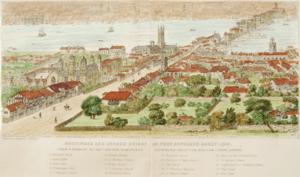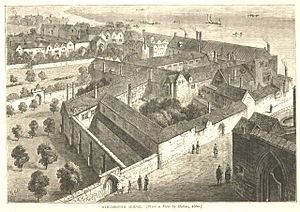Winchester Palace facts for kids
Quick facts for kids Winchester Hall |
|
|---|---|

Remains of the great hall of Winchester Palace showing the Rose Window and underneath the traditional arrangement of three doors from the screens passage to the buttery, pantry and kitchen.
|
|
| Location | Clink Street London, SE1 United Kingdom |
| Built | 12th century |
| Architectural style(s) | Medieval Tudor |
| Governing body | English Heritage |
| Reference no. | Grade II |
| Lua error in Module:Location_map at line 420: attempt to index field 'wikibase' (a nil value). | |
Winchester Palace was a large house in London. It was built in the 12th century for the Bishop of Winchester. This important palace was located in Southwark, on the south side of the River Thames. Today, you can still see some parts of the old palace. These remains are protected as a special historic site by English Heritage.
History of the Palace
The Bishop of Winchester was a very powerful person in England. He owned a lot of land in the Southwark area. The Bishop often worked as the king's treasurer, like a modern-day finance minister. He also had to attend meetings with the king in Westminster and at the Tower of London. Bishops also had to go to Parliament.
The city of Winchester used to be the capital city for the Saxon kings of England. Because of his important duties, Bishop Henry of Blois built Winchester Palace. It was his comfortable and grand home in London. Many other bishops also had large houses in London, like Lambeth Palace for the Archbishop of Canterbury.
The palace was used for many years, until the 17th century. Then, it was divided into smaller homes and storage areas. A big fire in 1814 destroyed most of the palace. Later, in the 19th and 20th centuries, more parts of the great hall and its beautiful rose window became visible. People believe the great hall was first built around the year 1136.
The hall was made bigger in the 14th century. The famous rose window was also added then. This work was possibly done by Bishop William of Wykeham.
Below the main hall was a fancy, vaulted cellar. It had a direct path to a wharf on the River Thames. This made it easy to bring in supplies by boat. Important guests, including King James I of Scotland, visited the palace. He was there for his wedding to Joan Beaufort, Queen of Scots in 1424. The palace had two main courtyards. It also had other buildings, like a prison, a place to make beer, and a butcher's shop. Outside, there was a garden, a tennis court, and a bowling alley.
During the Civil War, the palace was used as a prison.
The Clink Liberty
Close to the palace was an area called the Liberty of the Clink. This area was special because it was not controlled by the City of London. This meant that some activities that were not allowed in the City could happen openly here. For example, there were many places for gaming, bowling alleys, and theatres. The area got its name from the famous Clink prison that was located there. This prison is why we still say "in the clink" when someone is in prison.
Winchester Palace Today
The remaining parts of Winchester Palace are now a Scheduled Monument. This means they are protected by law. English Heritage looks after these important historical ruins.
See also
 In Spanish: Palacio de Winchester para niños
In Spanish: Palacio de Winchester para niños



